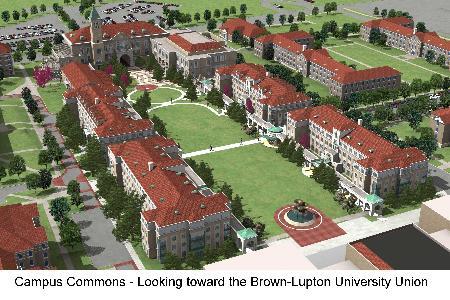TCU has come a long way since the fall of 1911, when the doors opened for the first semester in the current Fort Worth location. Initially, there were three buildings: an academic and administrative building called the Main, now Reed Hall, Jarvis Hall for the female students and a male dormitory named Goode, which was in the location of present-day Clark Hall. As former Emeritus Dean of Students, Libby Proffer’s “A History of TCU” explains, those original alumni didn’t have access to the ever-growing amenities the campus offers today.
Fast forward almost a century and TCU has grown to encompass 271 acres in a now vibrant section of the city. An annual budget of more than $350 million accommodates more than 8,600 students and 1,700 faculty members. As the TCU community has grown exponentially, university officials have kept pace by investing millions in infrastructure through renovation and new construction in all areas of the campus – and there is no end in sight.
Harold Leeman, associate director of major projects for the Physical Plant, said in addition to the $4 million invested each summer to modernize existing space and bring the latest technology to laboratories and classrooms across campus, there is a lengthy list of current and recently completed additions and many other projects being planned for the near future.
“Right now we have a couple of major projects in the design phase, but we don’t start construction on any building until the funding is completely secured,” Leeman said. “And we usually try to set up an endowment fund to maintain the building for 20 years as well.”
Leeman said a couple of big plans currently in the works are a 14,000-square foot admissions center to be built on the parking lot south of the Rickel building and a new Olympic-size sports center for spring sports such as baseball, track, golf and soccer.
If construction has been a staple on campus since the beginning, one thing is definitely new: a commitment to green building, which Leeman credits primarily to the vision of Chancellor Victor Boschini. Green building and renovating means giving consideration to efficiency and the environment every step of the way, from recycling of waste to high efficiency windows, lighting and heating and cooling units. Leeman said this approach is not as expensive as many believe.
“We have found that our initial cost on these buildings has only been around one percent higher,” he said. “And the savings provided by improving efficiency will make up the difference in just one or two years.”
Striking a balance between cost and energy efficiency are key determining factors from the design phase to project completion. Sustainability is the future of TCU and the university’s commitment to going green can be seen in many of the recently completed and ongoing projects, Leeman said.
Scharbauer Hall, the soon-to-be home of the AddRan College of Liberal Arts and the John V. Roach Honors College, is scheduled to open in January of 2010. After more than 20 years in temporary buildings, Andrew Schoolmaster, dean of AddRan, said the faculty and students in the college of liberal arts were ready to spread out in their new space. The 73,000-square foot, $25 million facility will have a new media lab, a debate chamber and an anthropology lab where the college’s bone collection will be housed.
“It has been a long time coming, but I think mostly it was just timing,” Schoolmaster said. “After the campus commons project was complete, Scharbauer was like the last piece of the puzzle.”
The academic hall is expected to receive Leadership in Energy and Environmental Design certification as a green building. High efficiency lighting, heating and cooling have been incorporated throughout. Waste from the project will be sorted and recycled and the landscaping around the building will be done with native plants and flowers that require less water.
The South End Zone Project, completed in August 2008, included a 24,500-square foot addition and 6,400 square feet of renovated space. The $13 million donor-funded project created 6 luxury suites, a private club and a seating deck with 250 club seats. The student athletes now have a large new team meeting room, a players’ club lounge and additional academic space.
Ross Bailey, associate director of athletics, said a unique good came out of the end zone project because the renovation created a source of revenue for the department. The proceeds from the luxury suites, which go for $35,000 per season, and the $2,000 club seats fund 16 new full-ride athletic scholarships.
“Rarely are people able to a give a gift that keeps on giving like this,” Bailey said. “It’s almost like an endowment fund because it’s going to keep giving back to the students for so many years to come.”
Plans to renovate the rest of the stadium from the ground up are still in the design phase and full funding has not yet been secured for the project, which will cost an estimated $120 million.
Residence hall renovations totaling $26 million have been completed on Clark and Sherley Halls. The buildings were reconfigured to provide more common areas, study lounges and laundry rooms as well as theater and media rooms. Ease of access and energy efficiency was also addressed in the redesign. After 50 years on campus, Sherley Hall was completely gutted for the renovation and is the first building on campus to receive LEED certification, a certification system created by the U.S. Green Building Council recognized around the world. The new space includes a baking center and a basement-level movie theater.
A $9 million renovation of Jarvis Hall transformed the all-female dorm into academic and administrative space. The third floor of Jarvis is now home to the School of Music.
Milton Daniel Hall is currently undergoing renovation and will provide more than 300 beds for students in the John V. Roach Honors College. The hall is scheduled to reopen in August 2010. Up next is Colby, which is tentatively scheduled to begin renovations in 2010, Allen said.
The Schieffer School of Journalism premiered a 2,300 square foot, $1.5 million convergence center this semester as the school completed the first phase of construction on Moudy South. The multi-platform media lab was designed to better prepare students to utilize audio, photography, video, print and the Internet platforms in the ever-changing world of mass communication. The convergence center serves as a central newsroom for the Daily Skiff newspaper, Image magazine and News Now broadcast.
Tommy Thomason, former director of the Schieffer School, said the convergence lab was a physical outgrowth from the idea of convergence, or the blending of communication mediums.
“We could see that media was converging rapidly,” Thomason said. “It really was a necessary investment in the education of our students to make them relevant in the fields they are going into.”
When Moudy South was built in the 1980s the school was only enrolling around 200 students. That number has since tripled and the number of faculty has doubled, Thomason said. An addition of 11,000 square feet on the third floor will provide additional academic and administrative space. Scheduled for completion in January 2010, the project’s total budget is around $5.6 million.
The Campus Commons Project, completed in August of 2008, brought a $100 million overhaul to the heart of campus. The project included four new residence halls, a new university union and a central green space.
The completion of the new Amon G. Carter and Kellye Wright Samuelson Halls, in the fall of 2007, and the Teresa and Luther King and Mary and Robert J. Wright Halls five months later provided more than 200,000 square feet of on-campus living space and cost more than $46 million. The residence halls were part of a larger goal to enhance the experience of the TCU community by bringing people together, Craig Allen, director of residential services, said. “It created a hub of activity where there used to be just a parking lot,” Allen said. “The unique features that were incorporated into the buildings’ designs have really given students a source of pride and a sense of community that goes beyond just brick and mortar.”
The project included landscaping in the center courtyard and relocation of Frog Fountain as well as the demolition of the existing student union and construction of the Brown-Lupton University Union. The 145,000-square foot union is home to a variety of eating options, a 600-seat ballroom, a 350-seat auditorium and conveniences for campus life such as a corner store, a post office and a health center.
Mike Russel, executive director of student affairs, said that changing the designation from student union to university union was significant.
“We wanted this to be a place for the entire TCU community,” Russel said. “Students, their families, faculty, staff and alumni . the new union gave us a place for everyone at the university to come together.”
All the projects stem from the university’s strategic plan, Vision in Action, and the Facility Master Plan, Russel said.
“It’s really about creating spaces that foster community and learning,” he said.
Don Mills, Vice Chancellor for Student Affairs, said the primary goals behind the growth and improvement of existing facilities have been to create a more residential campus and enhance academic facilities so that students can reach their full academic potential.
“The clear focus is to create a world class university experience,” he said. “Having the right academic, co-curricular and athletic facilities enables students to engage the programs, activities and events that create memorable and important experiences.”





